child restraint MAZDA MODEL MX-5 MIATA RF 2022 Owners Manual
[x] Cancel search | Manufacturer: MAZDA, Model Year: 2022, Model line: MODEL MX-5 MIATA RF, Model: MAZDA MODEL MX-5 MIATA RF 2022Pages: 503, PDF Size: 42.06 MB
Page 6 of 503
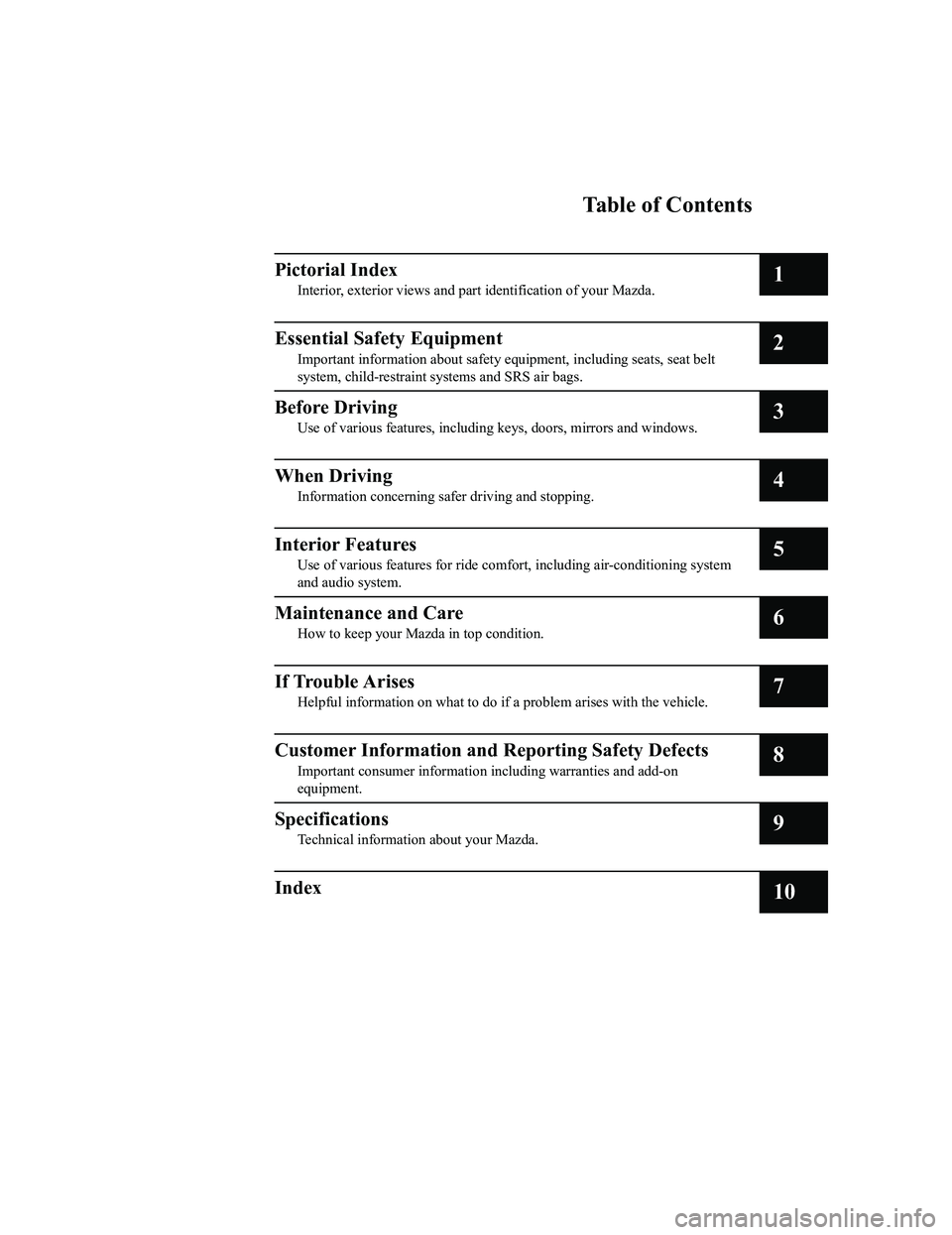
Table of Contents
Pictorial Index
Interior, exterior views and part identification of your Mazda.1
Essential Safety Equipment
Important information about safety e quipment, including seats, seat belt
system, child-restraint systems and SRS air bags.2
Before Driving
Use of various features, including keys, doors, mirrors and windows.3
When Driving
Information concerning safer driving and stopping.4
Interior Features
Use of various features for ride co mfort, including air-conditioning system
and audio system.5
Maintenance and Care
How to keep your Mazda in top condition.6
If Trouble Arises
Helpful information on what to do if a problem arises with the vehicle.7
Customer Information and Reporting Safety Defects
Important consumer informati on including warranties and add-on
equipment.8
Specifications
Technical information about your Mazda.9
Index10
MX-5_8KH8-EA-21K_Edition3_old 2021-11-10 13:10:56
Page 16 of 503
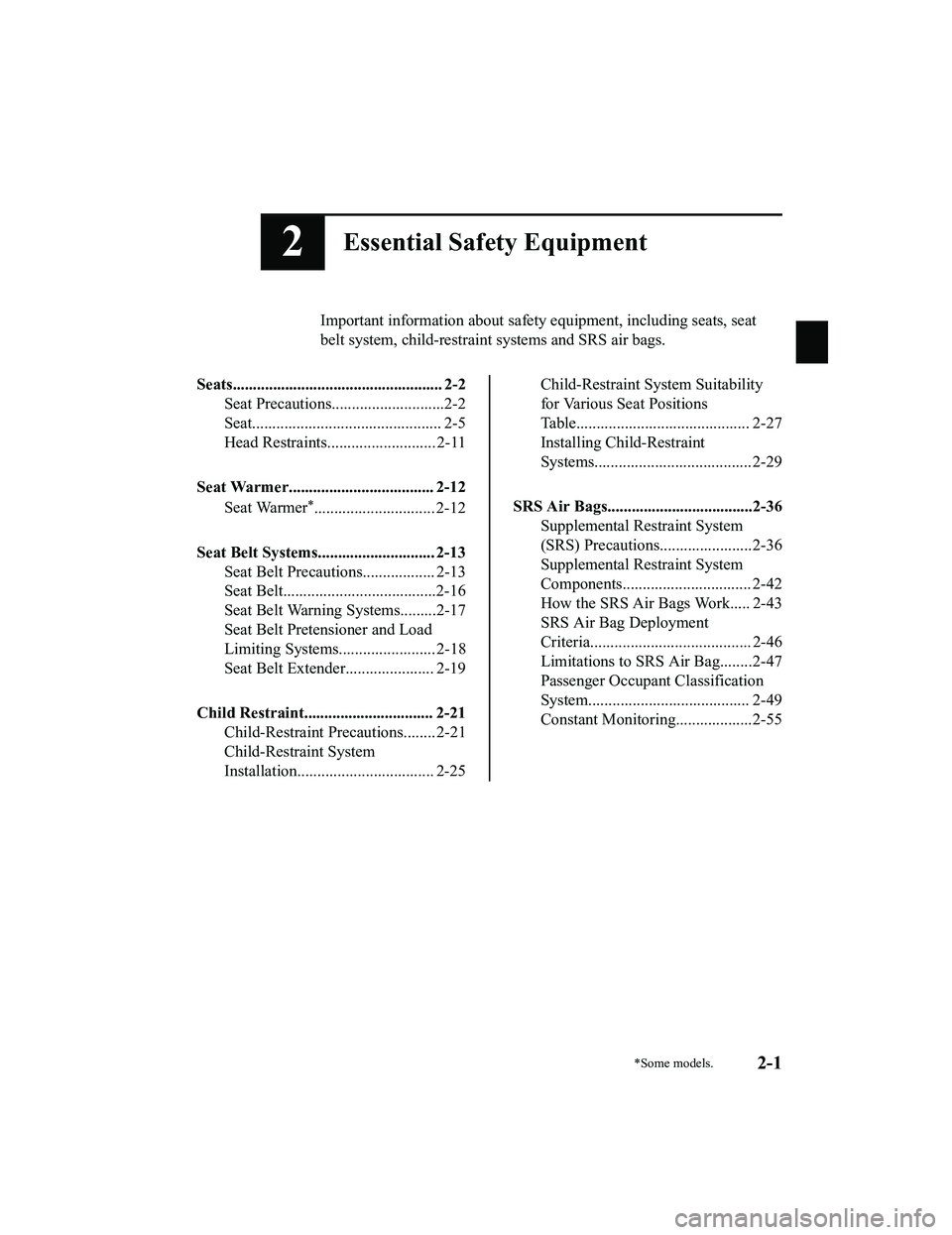
2Essential Safety Equipment
Important information about safety equipment, including seats, seat
belt system, child-restraint systems and SRS air bags.
Seats.................................................... 2-2 Seat Precautions............................2-2
Seat............................................... 2-5
Head Restraints........................... 2-11
Seat Warmer.................................... 2-12 Seat Warmer
*.............................. 2-12
Seat Belt Systems.. ........................... 2-13
Seat Belt Precautions.................. 2-13
Seat Belt......................................2-16
Seat Belt Warning Systems.........2-17
Seat Belt Pretensioner and Load
Limiting Systems........................ 2-18
Seat Belt Extender...................... 2-19
Child Restraint................................ 2-21 Child-Restraint Precautions........ 2-21
Child-Restraint System
Installation.................................. 2-25
Child-Restraint Sy stem Suitability
for Various Seat Positions
Table........................................... 2-27
Installing Child-Restraint
Systems....................................... 2-29
SRS Air Bags....................................2-36 Supplemental Restraint System
(SRS) Precautions.......................2-36
Supplemental Restraint System
Components................................ 2-42
How the SRS Air Bags Work..... 2-43
SRS Air Bag Deployment
Criteria........................................ 2-46
Limitations to SRS Air Bag........2-47
Passenger Occupant Classification
System........................................ 2-49
Constant Monitoring...................2-55
*Some models.2-1
MX-5_8KH8-EA-21K_Edition3_old 2021-11-10 13:10:56
Page 17 of 503
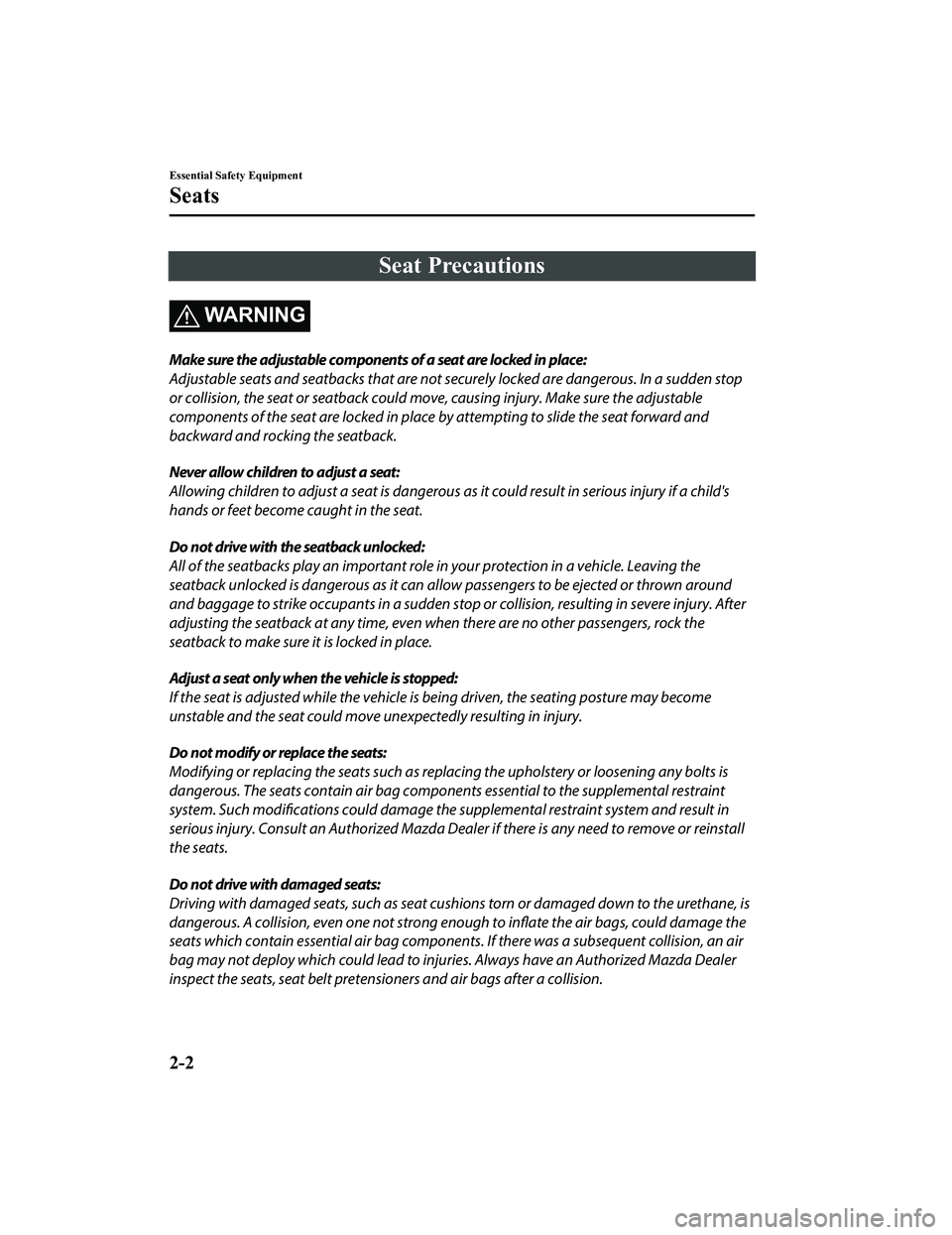
Seat Precautions
WA R N I N G
Make sure the adjustable components of a seat are locked in place:
Adjustable seats and seatbacks that are not securely locked are dangerous. In a sudden stop
or collision, the seat or seatback could move, causing injury. Make sure the adjustable
components of the seat are locked in place by attempting to slide the seat forward and
backward and rocking the seatback.
Never allow children to adjust a seat:
Allowing children to adjust a seat is dangerous as it could result in serious injury if a child's
hands or feet become caught in the seat.
Do not drive with the seatback unlocked:
All of the seatbacks play an important role in your protection in a vehicle. Leaving the
seatback unlocked is dangerous as it can a llow passengers to be ejected or thrown around
and baggage to strike occupants in a sudden stop or collision, resulting in severe injury. After
adjusting the seatback at any time, even when there are no other passengers, rock the
seatback to make sure it is locked in place.
Adjust a seat only when the vehicle is stopped:
If the seat is adjusted while the vehicle is being driven, the seating posture may become
unstable and the seat could move unexpectedly resulting in injury.
Do not modify or replace the seats:
Modifying or replacing the seats such as repl acing the upholstery or loosening any bolts is
dangerous. The seats contain air bag components essential to the supplemental restraint
system. Such modifications could damage the supplemental restraint system and result in
serious injury. Consult an Author ized Mazda Dealer if there is any need to remove or reinstall
the seats.
Do not drive with damaged seats:
Driving with damaged seats, such as seat cushions torn or damaged down to the urethane, is
dangerous. A collision, even one not strong enou gh to inflate the air bags, could damage the
seats which contain essential air bag components. If there was a subsequent collision, an air
bag may not deploy which could lead to injuri es. Always have an Authorized Mazda Dealer
inspect the seats, seat belt pretensioners and air bags after a collision.
Essential Safety Equipment
Seats
2-2
MX-5_8KH8-EA-21K_Edition3_old 2021-11-10 13:10:56
Page 28 of 503
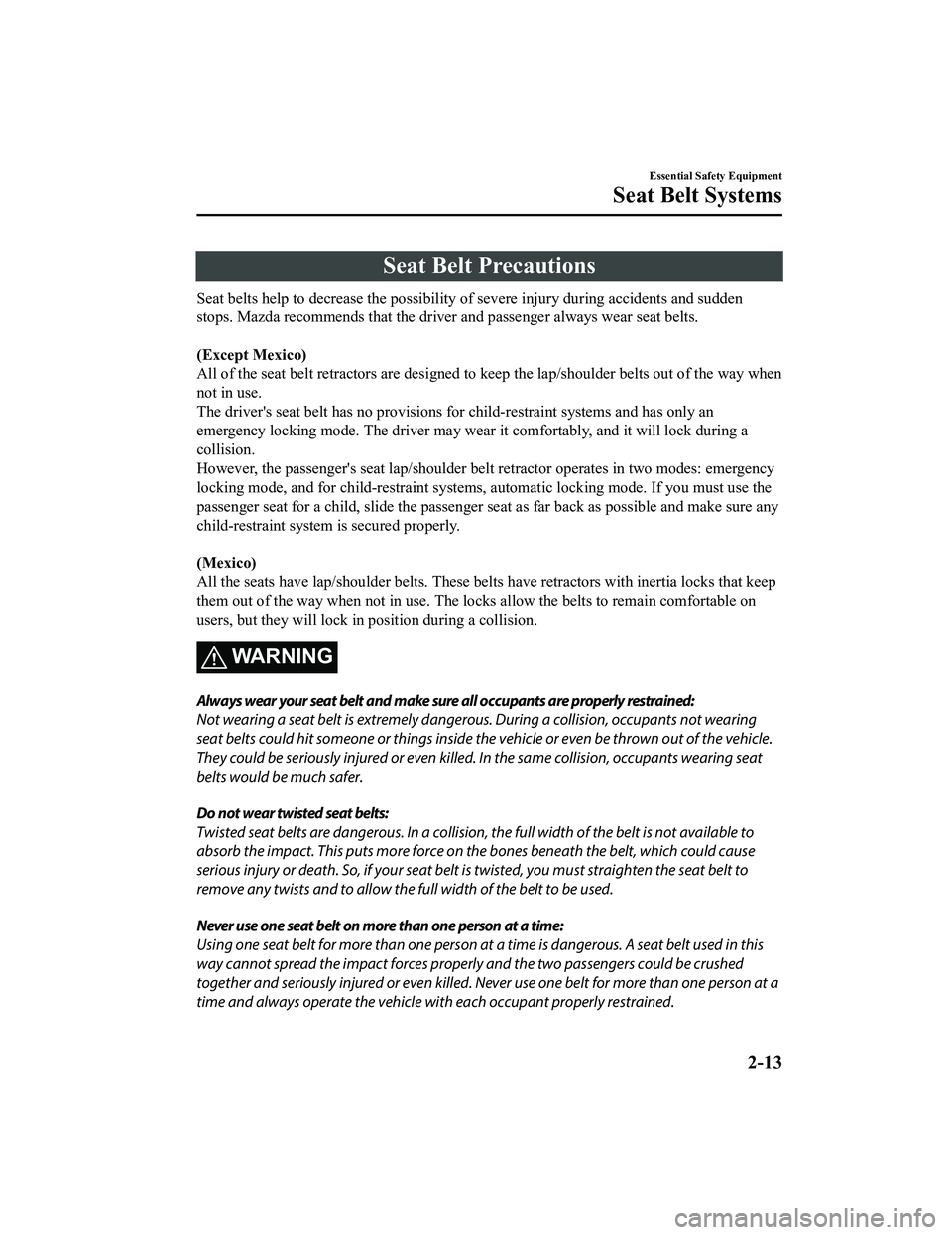
Seat Belt Precautions
Seat belts help to decrease the possibility of severe injury during accidents and sudden
stops. Mazda recommends that the driver and passenger always wear seat belts.
(Except Mexico)
All of the seat belt retractors are designed to keep the lap/shoulder belts out of the way when
not in use.
The driver's seat belt has no provisions for child-restraint systems and has only an
emergency locking mode. The driver may wear it comfortably, and it will lock during a
collision.
However, the passenger's seat lap/shoulder belt retractor operates in two modes: emergency
locking mode, and for child-restraint systems, automatic locking mode. If you must use the
passenger seat for a chil d, slide the passenger seat as far b ack as possible and make sure any
child-restraint system is secured properly.
(Mexico)
All the seats have lap/shoulder belts. These belts have retractors with inertia locks that keep
them out of the way when not in use. The lo cks allow the belts to remain comfortable on
users, but they will lock in position during a collision.
WARNING
Always wear your seat belt and make sure all occupants are properly restrained:
Not wearing a seat belt is extremely dangerou s. During a collision, occupants not wearing
seat belts could hit someone or things inside the vehicle or even be thrown out of the vehicle.
They could be seriously injured or even killed. In the same collision, occupants wearing seat
belts would be much safer.
Do not wear twisted seat belts:
Twisted seat belts are dangerous. In a collision, the full width of the belt is not available to
absorb the impact. This puts more force on the bones beneath the belt, which could cause
serious injury or death. So, if your seat belt is twisted, you must straighten the seat belt to
remove any twists and to allow the full width of the belt to be used.
Never use one seat belt on more than one person at a time:
Using one seat belt for more than one person at a time is dangerous. A seat belt used in this
way cannot spread the impact forces properly and the two passengers could be crushed
together and seriously injured or even killed. Ne ver use one belt for more than one person at a
time and always operate the vehicle wi th each occupant properly restrained.
Essential Safety Equipment
Seat Belt Systems
2-13
MX-5_8KH8-EA-21K_Edition3_old 2021-11-10 13:10:56
Page 30 of 503
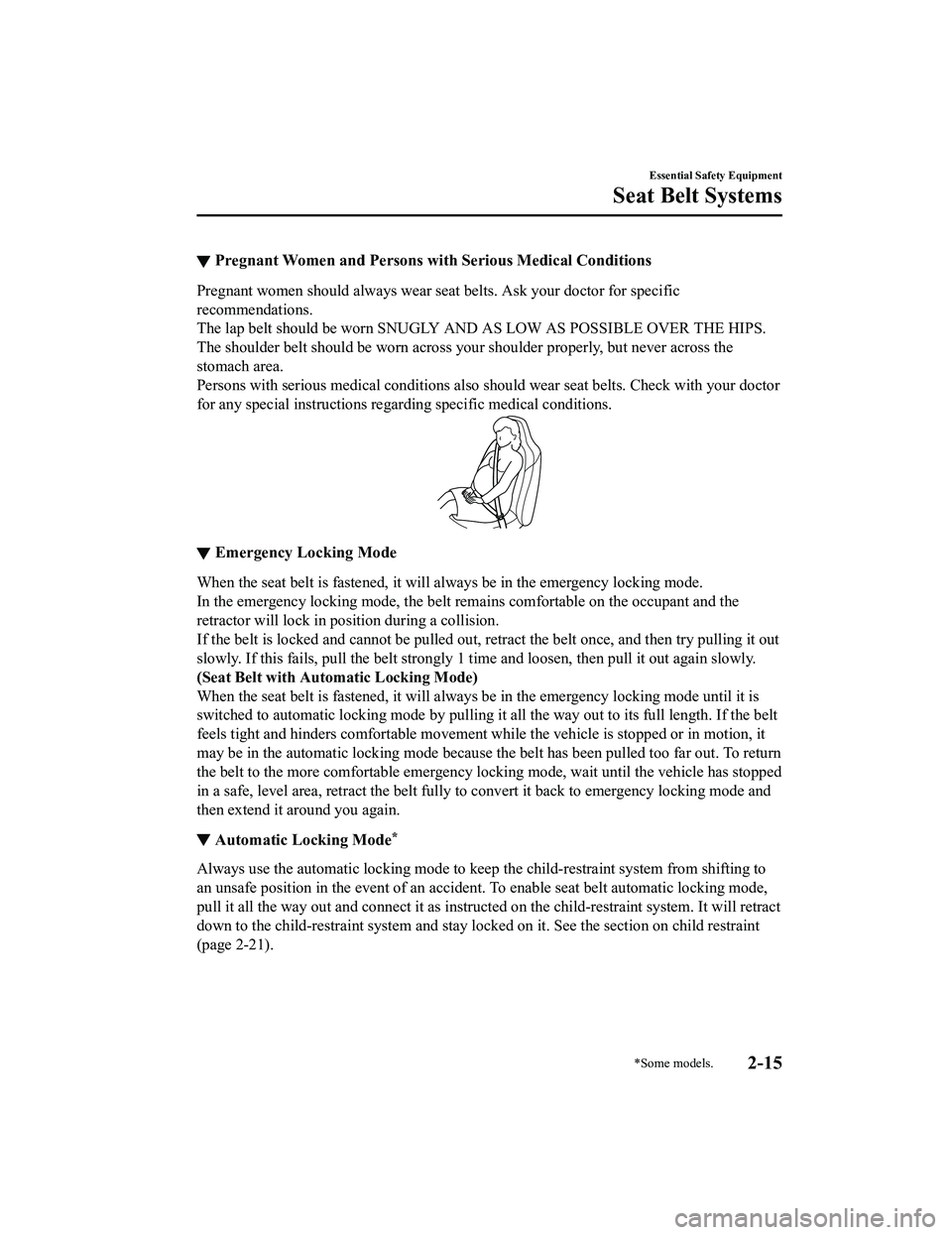
▼Pregnant Women and Persons wi
th Serious Medical Conditions
Pregnant women should always wear seat belts. Ask your doctor for specific
recommendations.
The lap belt should be worn SNUGLY AND AS LOW AS POSSIBLE OVER THE HIPS.
The shoulder belt should be worn across your shoulder properly, but never across the
stomach area.
Persons with serious medical conditions also should wear seat belts. Check with your doctor
for any special instructions regarding specific medical conditions.
▼Emergency Locking Mode
When the seat belt is fastened, it will
always be in the emergency locking mode.
In the emergency locking mode , the belt remains comfortable on the occupant and the
retractor will lock in position during a collision.
If the belt is locked and cannot be pulled out, retract the belt once, and then try pulling it out
slowly. If this fails, pull the belt strongly 1 time and loosen, then pull it out again slowly.
(Seat Belt with Auto matic Locking Mode)
When the seat belt is fastened, it will always be in the emergency locking mode until it is
switched to automatic locking mode by pulling it all the way out to its full length. If the belt
feels tight and hinders comfortable movement while the vehicle is stopped or in motion, it
may be in the automatic locking mode because the belt has been pulled too far out. To return
the belt to the more comfortable emergency lo cking mode, wait until the vehicle has stopped
in a safe, level area, retract the belt fully to convert it back to emergency locking mode and
then extend it around you again.
▼ Automatic Locking Mode*
Always use the automatic locking mode to keep
the child-restraint system from shifting to
an unsafe position in the event of an accident. To enable seat belt automatic locking mode,
pull it all the way out and connect it as instructed on the child-restraint system. It will retract
down to the child-restra int system and stay locked on it. See the section on child restraint
(page 2-21).
Essential Safety Equipment
Seat Belt Systems
*Some models.2-15
MX-5_8KH8-EA-21K_Edition3_old 2021-11-10 13:10:56
Page 35 of 503
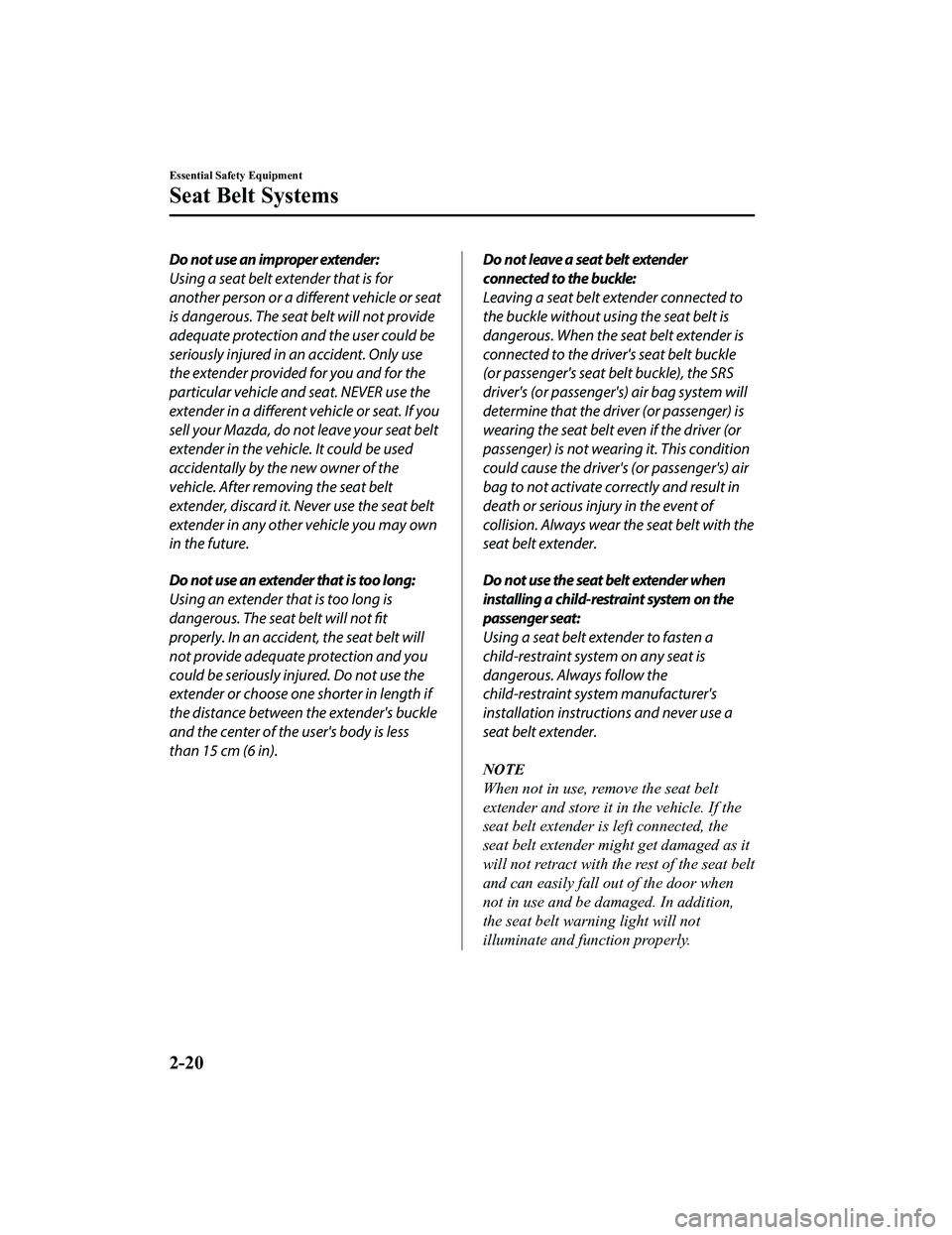
Do not use an improper extender:
Using a seat belt extender that is for
another person or a different vehicle or seat
is dangerous. The seat belt will not provide
adequate protection and the user could be
seriously injured in an accident. Only use
the extender provided for you and for the
particular vehicle and seat. NEVER use the
extender in a different vehicle or seat. If you
sell your Mazda, do not leave your seat belt
extender in the vehicle. It could be used
accidentally by the new owner of the
vehicle. After removing the seat belt
extender, discard it. Never use the seat belt
extender in any other vehicle you may own
in the future.
Do not use an extender that is too long:
Using an extender that is too long is
dangerous. The seat belt will not fit
properly. In an accide nt, the seat belt will
not provide adequate protection and you
could be seriously injured. Do not use the
extender or choose one shorter in length if
the distance between the extender's buckle
and the center of the user's body is less
than 15 cm (6 in).Do not leave a seat belt extender
connected to the buckle:
Leaving a seat belt extender connected to
the buckle without using the seat belt is
dangerous. When the seat belt extender is
connected to the driver's seat belt buckle
(or passenger's seat belt buckle), the SRS
driver's (or passenger's) air bag system will
determine that the driver (or passenger) is
wearing the seat belt even if the driver (or
passenger) is not wearing it. This condition
could cause the driver's (or passenger's) air
bag to not activate correctly and result in
death or serious injury in the event of
collision. Always wear the seat belt with the
seat belt extender.
Do not use the seat belt extender when
installing a child-restraint system on the
passenger seat:
Using a seat belt extender to fasten a
child-restraint system on any seat is
dangerous. Always follow the
child-restraint system manufacturer's
installation instructions and never use a
seat belt extender.
NOTE
When not in use, remove the seat belt
extender and store it in the vehicle. If the
seat belt extender is left connected, the
seat belt extender might get damaged as it
will not retract with the rest of the seat belt
and can easily fall out of the door when
not in use and be damaged. In addition,
the seat belt warning light will not
illuminate and function properly.
Essential Safety Equipment
Seat Belt Systems
2-20
MX-5_8KH8-EA-21K_Edition3_old 2021-11-10 13:10:56
Page 36 of 503
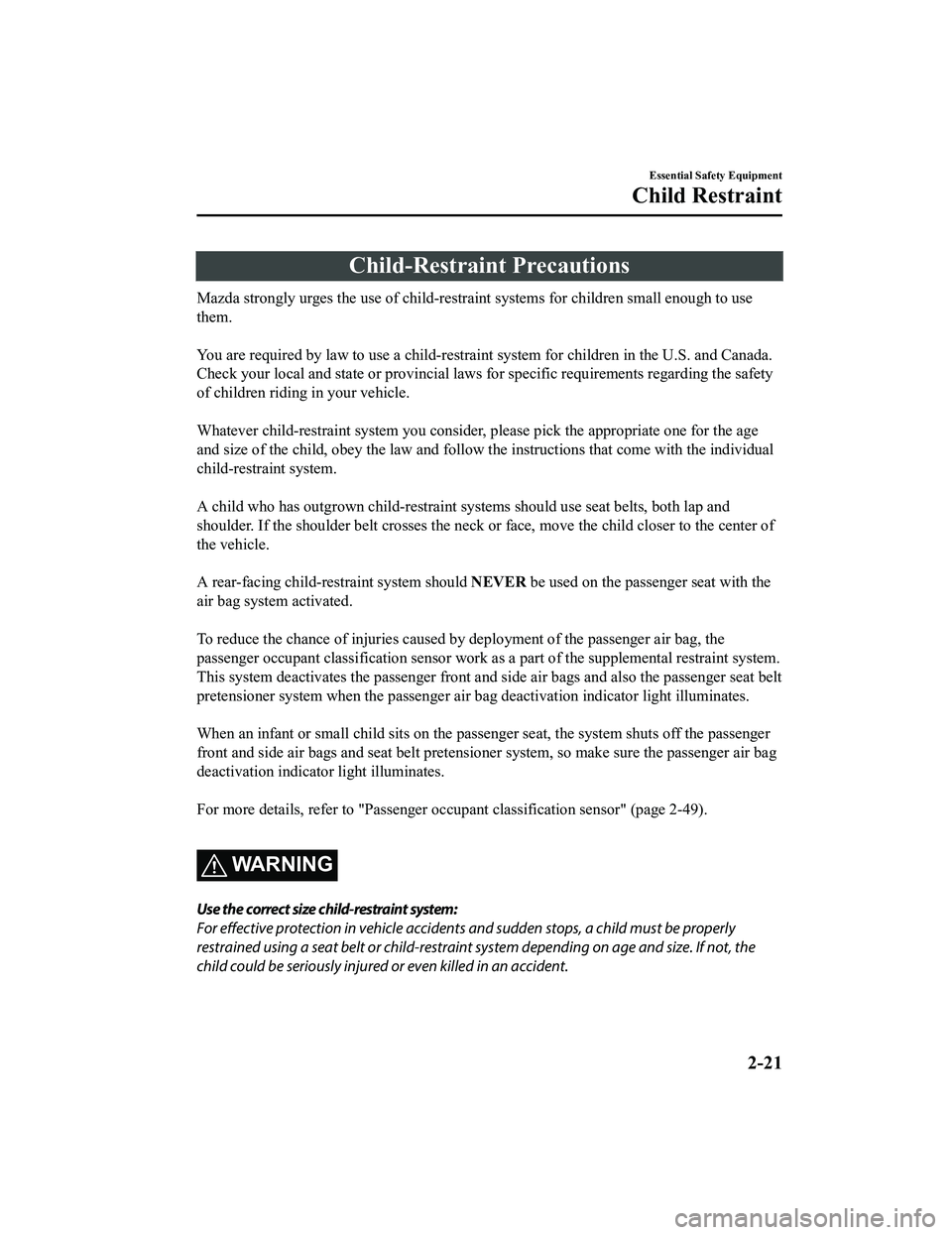
Child-Restraint Precautions
Mazda strongly urges the use of child-restraint systems for children small enough to use
them.
You are required by law to use a child-restraint system for children in the U.S. and Canada.
Check your local and state or provincial laws for specific requirements regarding the safety
of children riding in your vehicle.
Whatever child-restraint system you consider, please pick the appropriate one for the age
and size of the child, obey the law and follow the instructions that come with the individual
child-restraint system.
A child who has outgrown child-restraint syst ems should use seat belts, both lap and
shoulder. If the shoulder belt crosses the neck or face, move the child closer to the center of
the vehicle.
A rear-facing child-res traint system should NEVER be used on the passenger seat with the
air bag system activated.
To reduce the chance of injuries caused by deployment of the passenger air bag, the
passenger occupant classification sensor work as a part of the supplemental restraint system.
This system deactivates the passenger front and side air bags and also the passenger seat belt
pretensioner system when the passenger air bag deactivation indicator light illuminates.
When an infant or small child sits on the passenger seat, the system shuts off the passenger
front and side air bags and seat belt pretensioner system, so make sure the passenger air bag
deactivation indicator light illuminates.
For more details, refer to "Passenger oc cupant classification sensor" (page 2-49).
WARNING
Use the correct size child-restraint system:
For effective protection in ve hicle accidents and sudden stop s, a child must be properly
restrained using a seat belt or child-restraint system depending on age and size. If not, the
child could be seriously injured or even killed in an accident.
Essential Safety Equipment
Child Restraint
2-21
MX-5_8KH8-EA-21K_Edition3_old 2021-11-10 13:10:56
Page 37 of 503
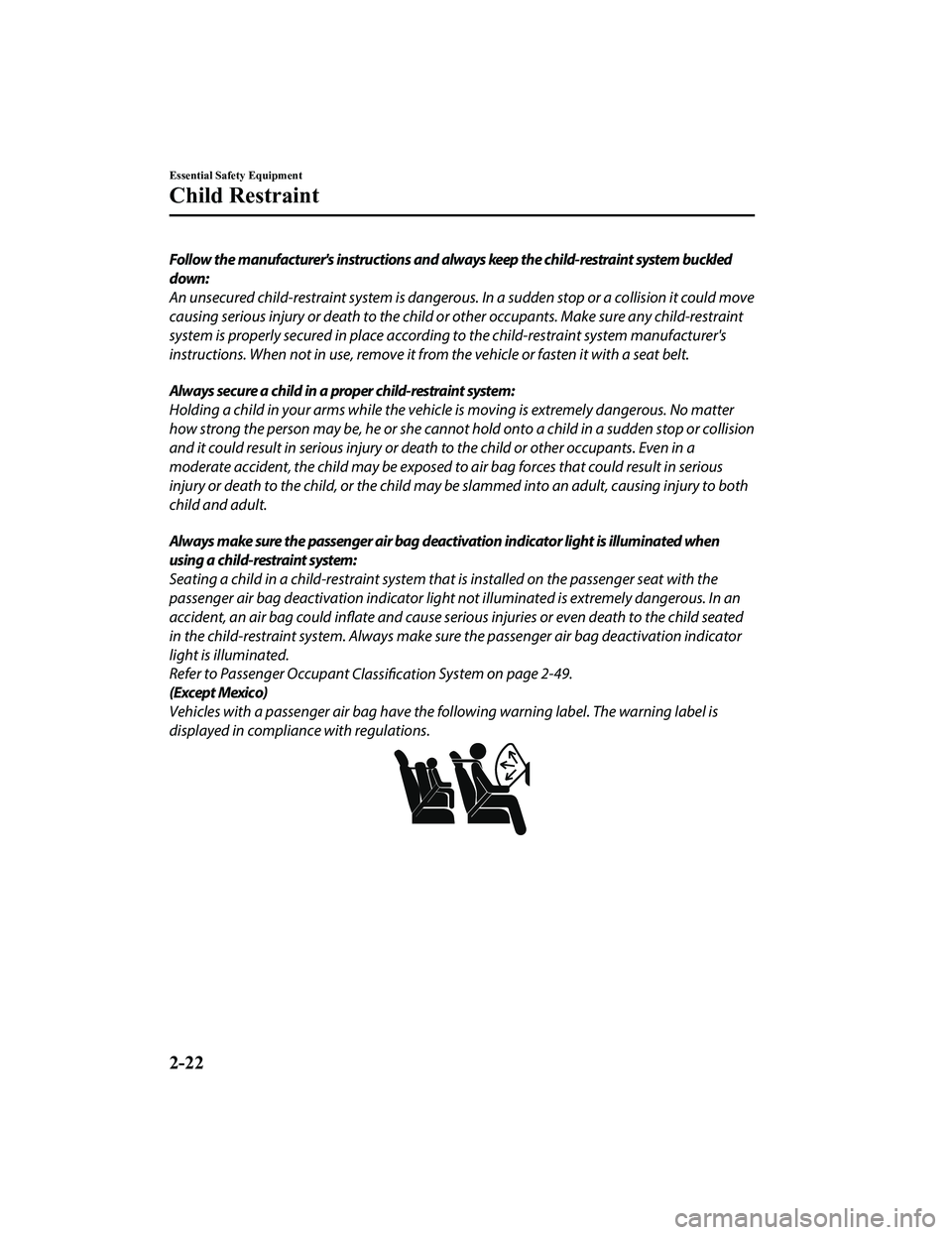
Follow the manufacturer's instructions and always keep the child-restraint system buckled
down:
An unsecured child-restraint system is dangerous. In a sudden stop or a collision it could move
causing serious injury or death to the child or other occupants. Make sure any child-restraint
system is properly secured in place according to the child-restraint system manufacturer's
instructions. When not in use, remove it from the vehicle or fasten it with a seat belt.
Always secure a child in a proper child-restraint system:
Holding a child in your arms while the vehicle is moving is extremely dangerous. No matter
how strong the person may be, he or she cannot hold onto a child in a sudden stop or collision
and it could result in serious injury or death to the child or other occupants. Even in a
moderate accident, the child may be exposed to air bag forces that could result in serious
injury or death to the child, or the child may be slammed into an adult, causing injury to both
child and adult.
Always make sure the passenger air bag deactivation indicator light is illuminated when
using a child-restraint system:
Seating a child in a child-restraint system that is installed on the passenger seat with the
passenger air bag deactivation indicator light not illuminated is extremely dangerous. In an
accident, an air bag could inflate and cause serious injuries or even death to the child seated
in the child-restraint system. Always make sure the passenger air bag deactivation indicator
light is illuminated.
Refer to Passenger Occupant Classification System on page 2-49.
(Except Mexico)
Vehicles with a passenger air bag have the fo llowing warning label. The warning label is
displayed in compliance with regulations.
Essential Safety Equipment
Child Restraint
2-22
MX-5_8KH8-EA-21K_Edition3_old 2021-11-10 13:10:56
Page 38 of 503
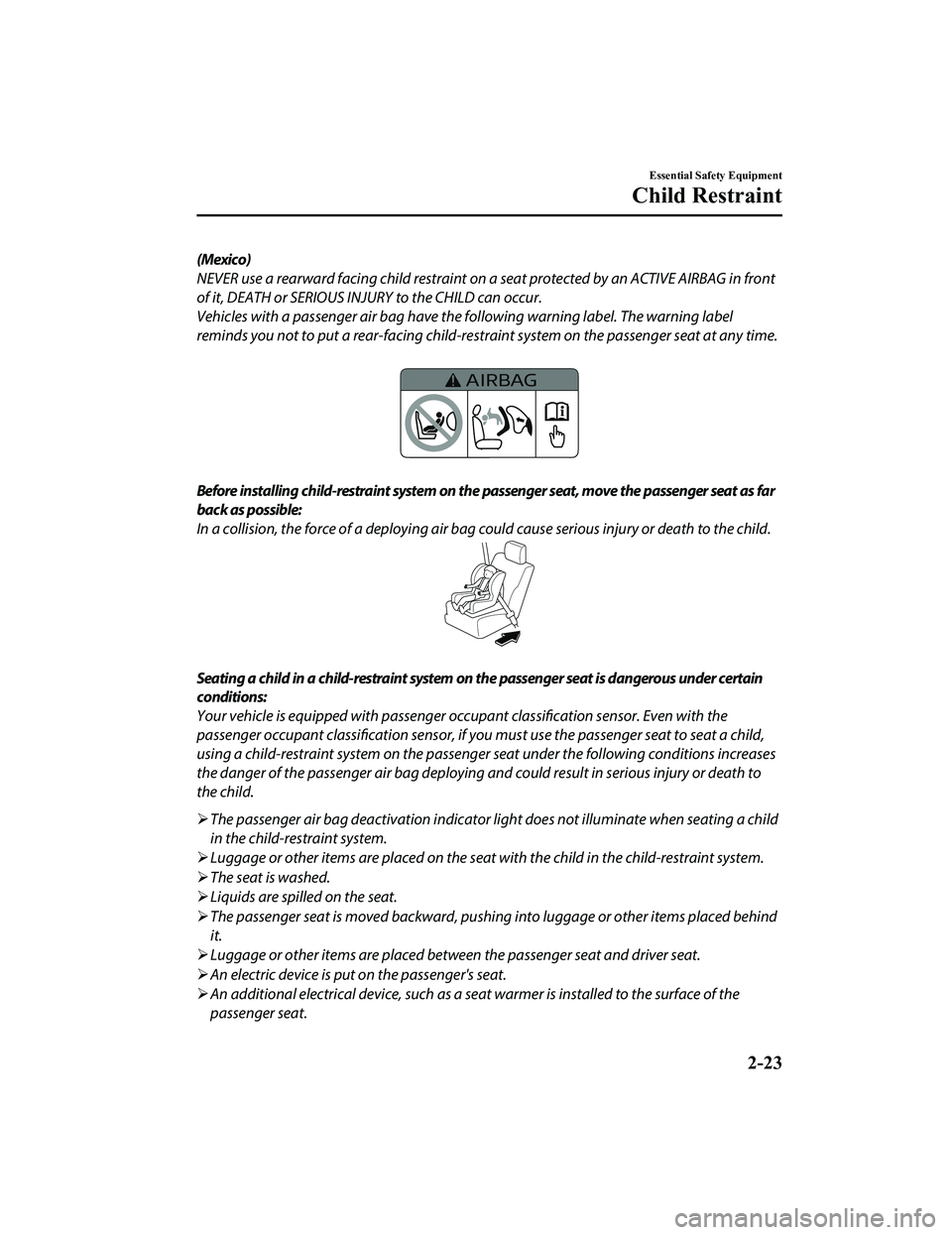
(Mexico)
NEVER use a rearward facing child restraint on a seat protected by an ACTIVE AIRBAG in front
of it, DEATH or SERIOUS INJURY to the CHILD can occur.
Vehicles with a passenger air bag have the following warning label. The warning label
reminds you not to put a rear-facing child-restrai nt system on the passenger seat at any time.
Before installing child-restraint system on the passenger seat, move the passenger seat as far
back as possible:
In a collision, the force of a deploying air bag could cause serious injury or death to the child.
Seating a child in a child-restraint system on the passenger seat is dangerous under certain
conditions:
Your vehicle is equipped with passenger occupant
classification sensor. Even with the
passenger occupant classification sensor, if you must use the passenger seat to seat a child,
using a child-restraint system on the passenger seat under the following conditions increases
the danger of the passenger air bag deploying and could result in serious injury or death to
the child.
The passenger air bag deactivation indicator ligh t does not illuminate when seating a child
in the child-restraint system.
Luggage or other items are placed on the seat with the child in the child-restraint system.
The seat is washed.
Liquids are spilled on the seat.
The passenger seat is moved backward, pushing into luggage or other items placed behind
it.
Luggage or other items are placed between the passenger seat and driver seat.
An electric device is put on the passenger's seat.
An additional electrical device, such as a seat warmer is installed to the surface of the
passenger seat.
Essential Safety Equipment
Child Restraint
2-23
MX-5_8KH8-EA-21K_Edition3_old 2021-11-10 13:10:56
Page 39 of 503
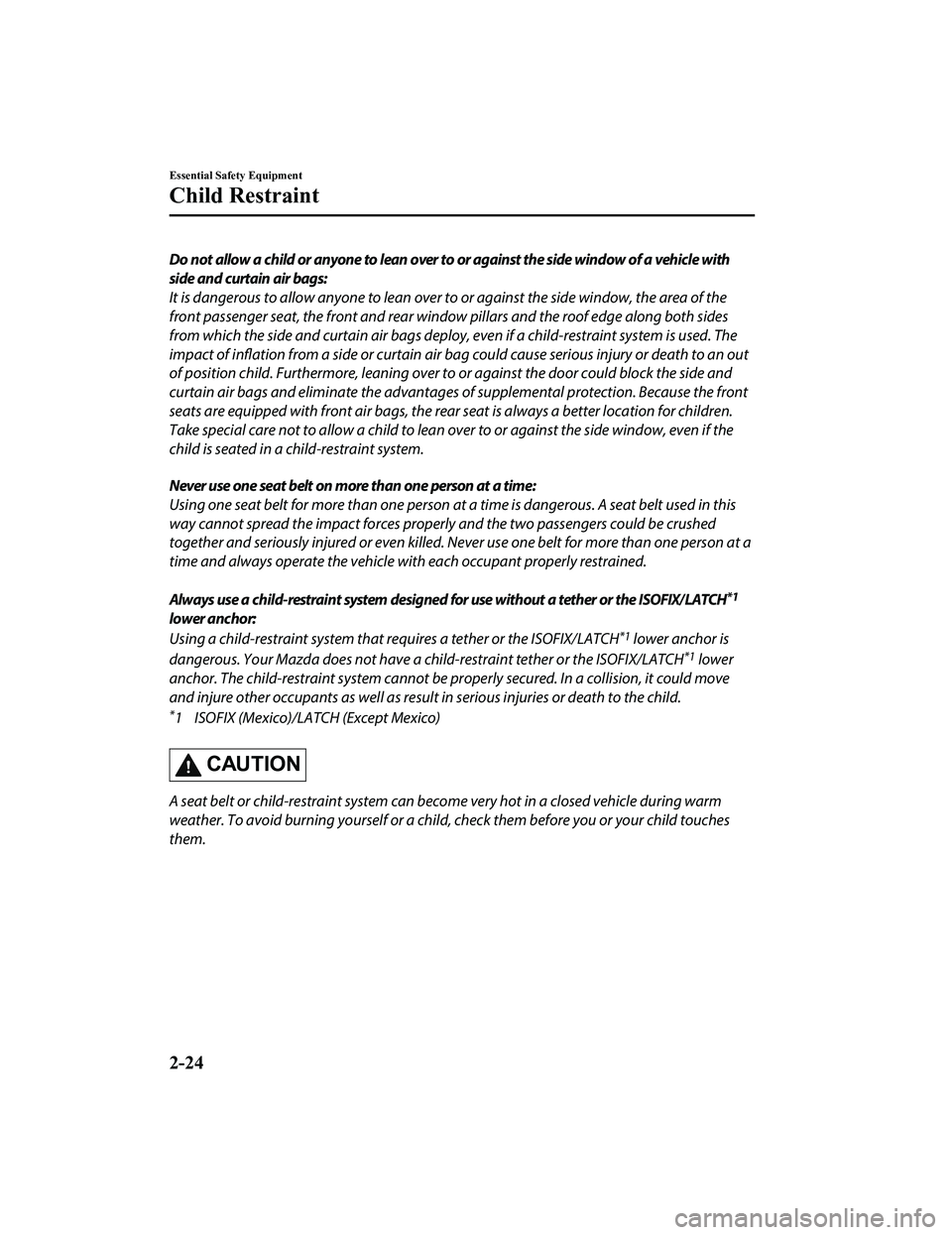
Do not allow a child or anyone to lean over to or against the side window of a vehicle with
side and curtain air bags:
It is dangerous to allow anyone to lean over to or against the side window, the area of the
front passenger seat, the front and rear window pillars and the roof edge along both sides
from which the side and curtain air bags deploy, even if a child-restraint system is used. The
impact of inflation from a side or curtain air ba g could cause serious injury or death to an out
of position child. Furthermore, leaning over to or against the door could block the side and
curtain air bags and eliminate the advantages of supplemental protection. Because the front
seats are equipped with front air bags, the rear seat is always a better location for children.
Take special care not to allow a child to lean ov er to or against the side window, even if the
child is seated in a child-restraint system.
Never use one seat belt on more than one person at a time:
Using one seat belt for more than one person at a time is dangerous. A seat belt used in this
way cannot spread the impact forces properly and the two passengers could be crushed
together and seriously injured or even killed. Never use one belt for more than one person at a
time and always operate the vehicle with each occupant properly restrained.
Always use a child-restraint system designed for use without a tether or the ISOFIX/LATCH
*1
lower anchor:
Using a child-restraint system that requires a tether or the ISOFIX/LATCH
*1 lower anchor is
dangerous. Your Mazda does not have a ch ild-restraint tether or the ISOFIX/LATCH
*1 lower
anchor. The child-restraint system cannot be pr operly secured. In a collision, it could move
and injure other occupants as well as result in serious injuries or death to the child.
*1 ISOFIX (Mexico)/LATCH (Except Mexico)
CAUTION
A seat belt or child-restraint system can beco me very hot in a closed vehicle during warm
weather. To avoid burning yourself or a child, check them before you or your child touches
them.
Essential Safety Equipment
Child Restraint
2-24
MX-5_8KH8-EA-21K_Edition3_old 2021-11-10 13:10:56